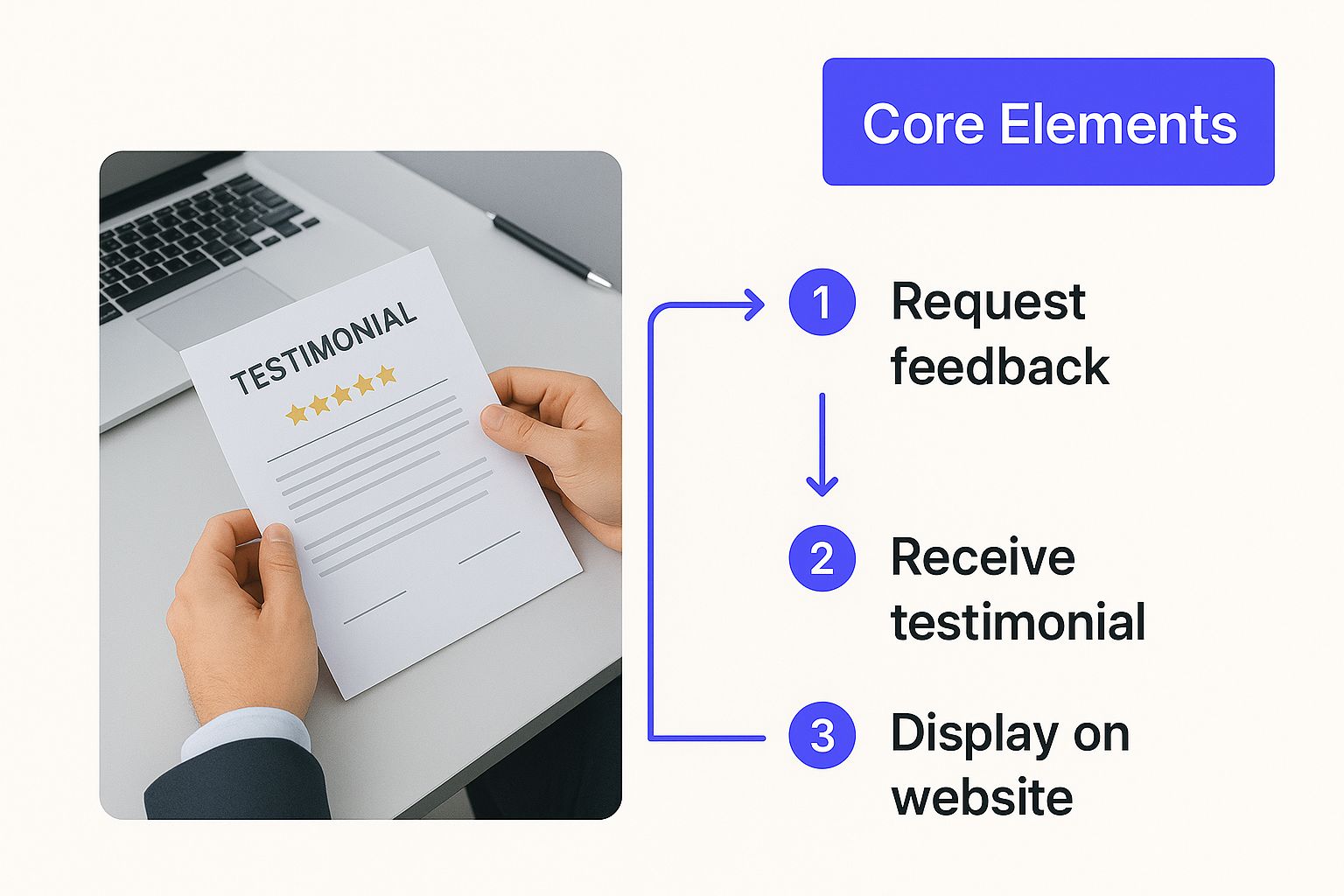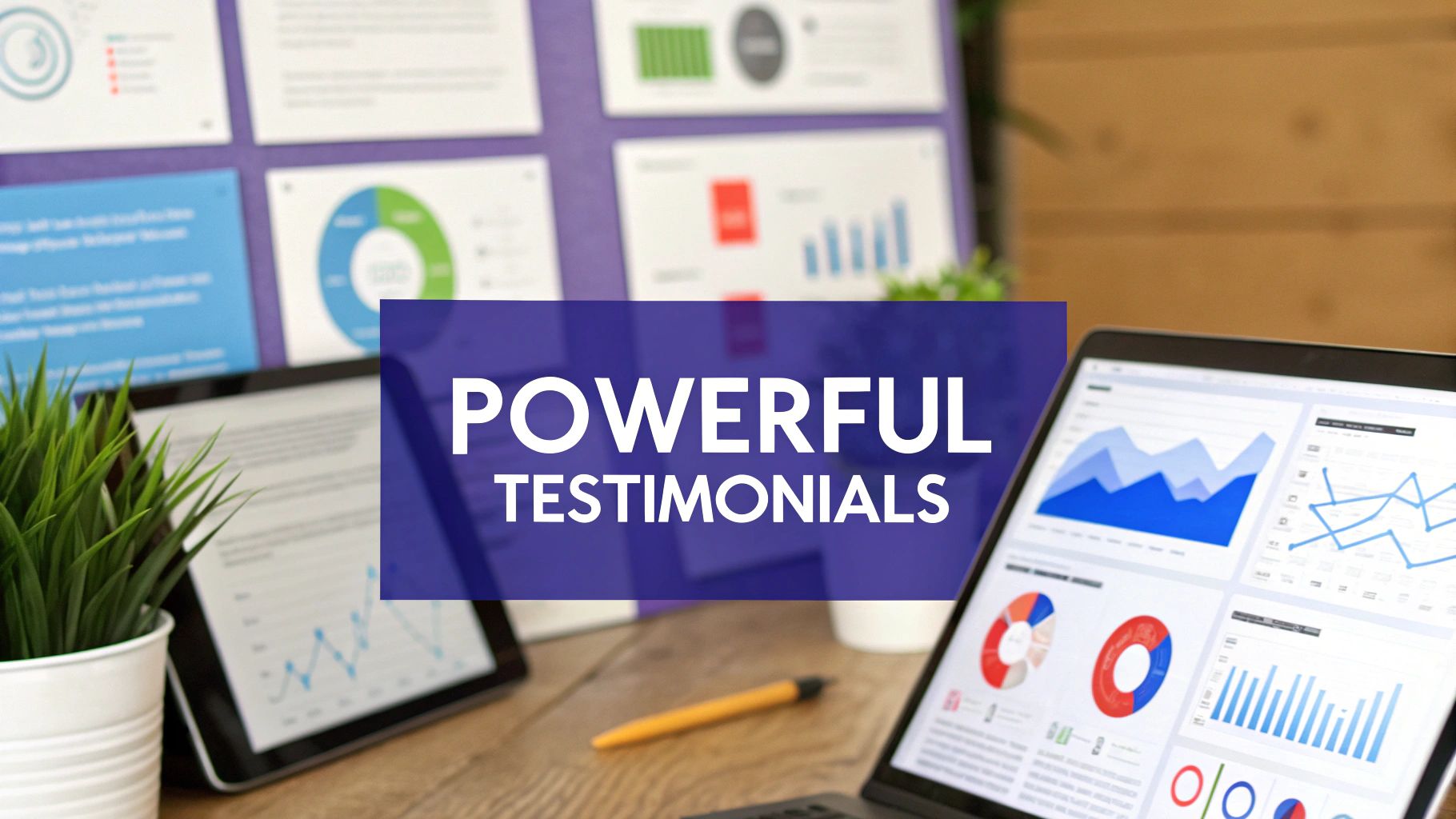A Proven Template for a Testimonial
Discover a powerful template for a testimonial that builds trust and drives sales. Learn how to get and use reviews that turn prospects into customers.

When you ask for a testimonial, you are not just fishing for compliments. You are trying to capture a genuine story. A simple template is your best tool for this. It guides your happy customers to share the details that matter most: their initial problem, how you solved it, and the specific results they saw.
This simple shift takes a generic "They're great!" into a powerful story that actually builds trust.
The Real Power of a Testimonial Template
A structured way of gathering feedback does more than just fill your website with nice quotes. It is about laying a foundation of trust for your brand, one customer story at a time. When a potential buyer sees that someone just like them solved the exact same problem with your product, it creates an instant connection.
That’s social proof in action.
Think about it: who would you rather trust? A company telling you how great their product is, or a peer who has already been there and done that? Authentic stories from your customers answer the questions and hesitations new buyers have before they even ask.
Building Confidence and Answering Questions Early
A really solid testimonial can actually shorten your sales cycle. It tackles objections head-on by showing prospects a clear path from where they are now (frustrated and looking for a solution) to a successful outcome. It makes the decision to buy feel a whole lot safer.
The numbers back this up. In the United States, a staggering 68% of marketing leaders see customer testimonials as a core part of building that initial trust with buyers. Research also shows that 42% of executives directly link trust to how engaged their customers are, and 61% of consumers will happily recommend a company they trust to friends and family. If you're curious, you can dig into even more statistics on testimonial impact for building confidence.
The goal isn’t just to collect praise. It is to use your customers' authentic voices to show the real-world value you deliver, turning their success stories into your most convincing marketing.
Creating a Human Connection
Beyond the facts and figures, testimonials create a genuine human connection. They tell a story that hits on an emotional level. A potential customer can see themselves in the shoes of someone who was struggling with the very same issue they're facing right now.
This is something traditional advertising rarely achieves. It makes your brand feel more relatable, more real. By using a template, you can consistently capture these powerful narratives, making sure every single testimonial you gather helps build a stronger, more trusted brand that fuels real growth.
The Anatomy of a Powerful Testimonial
The most effective testimonials are not just a string of compliments. They tell a story. Think of it as a repeatable narrative arc that walks a potential customer from their initial problem to their ultimate success. When you understand this structure, you can build a simple template for a testimonial that consistently captures the full, persuasive story.
Forget vague praise like "great service." A truly impactful testimonial is built on three core pillars that work in tandem. This structure helps future customers see themselves in the story and understand the real-world value you deliver.
The Problem Before Your Solution
Every great story needs a starting point, a challenge to overcome. A compelling testimonial is no different. It has to begin by setting the scene, describing the specific problem, frustration, or pain point the customer was struggling with before they found you.
This part is absolutely important for building relevance. When a prospect reads about a problem they're currently facing, they're hooked. You want to paint a vivid picture of the "before" state to make the "after" feel that much more impressive.
Getting this information means asking the right questions. Instead of the generic "How did you find us?", dig deeper:
- What specific challenge were you trying to solve when you discovered us?
- What other solutions had you tried, and what went wrong?
This visual guide breaks down the important parts of a compelling testimonial, giving you a clear framework to follow.

By focusing on these distinct parts (the initial problem, the specific results, and the overall experience) you can build a more complete and convincing customer story.
To help you get started, here's a table outlining the key components you should aim to capture in every testimonial.
Key Components of an Effective Testimonial
Following this structure helps you move beyond generic quotes and into crafting complete stories that resonate with and convert new customers.
Specific and Measurable Results
After you've established the problem, your story needs a resolution. This is where you show off the tangible, concrete results the customer achieved. The more specific and data-driven you can be here, the more credible your testimonial will be.
Numbers simply cut through the noise. Saying you "increased efficiency" is nice, but saying you "reduced project completion time by 30%" is powerful. Quantifiable outcomes offer undeniable proof that your solution actually works.
A great testimonial moves beyond feelings and into facts. It provides hard evidence that answers a prospect's biggest question: "Will this actually work for me?"
If you struggle to get these details, guide your customers with targeted questions. A simple "What measurable improvements have you seen since using our service?" can work wonders. For more inspiration, you can find additional guidance on how to write testimonials by exploring proven techniques and examples.
The Experience and Final Recommendation
Finally, a strong testimonial touches on the human element. What was it really like to work with your company? This part of the story covers the customer experience, the quality of your support, and the overall feeling they were left with.
This section adds an important emotional layer to the logical proof you’ve already provided. It helps prospects understand not just what you do, but how you do it. A glowing review about your helpful support team or seamless onboarding process can be the final nudge that convinces someone to choose you over a competitor.
Putting the Testimonial Template to Work
Okay, let's stop talking theory and look at how this actually works. It is one thing to have a template, but it is another to see how a few key elements can turn a bland review into a powerful story that sells.
We're going to break down a couple of real-world examples from different industries. You'll see how they all use the same core recipe: start with the problem, introduce the solution, and then describe the result.
Don't underestimate the power of these stories. When you hear that 93% of people say online reviews influence what they buy, you start to see why getting this right is so important. If you want to dive deeper into the psychology, there's a ton of great data on how social proof shapes buyer decisions.
SaaS Testimonial Example
For software companies, it's all about the results. Vague praise just doesn't cut it when people are making a significant investment. Potential customers need to see specific, data-backed improvements.
"Our team was constantly missing deadlines. We were trying to manage everything with a chaotic mix of spreadsheets and email chains, and communication was a total mess. After just one month with ProjectFlow, we cut our project completion time by 25%. I have to give a shout-out to their support team, too. They were amazing during onboarding."
This is a great example. It paints a clear "before" picture of missed deadlines and messy communication. Then, it delivers a quantifiable "after" with that 25% improvement. The mention of the helpful support team is the perfect finishing touch, adding a human element that builds extra trust.
E-commerce Testimonial Example
With e-commerce, the focus shifts. Here, testimonials are important for building trust in the product's quality and the reliability of the company. It is all about overcoming the natural hesitation people have about buying something they can't see or touch first.

"I was so nervous about ordering a custom desk online. I was sure it wouldn't look as good as the pictures. But the desk from Urban Timber is absolutely perfect! It even arrived a week early, and the quality is just outstanding. It’s completely transformed my home office."
This review is brilliant because it tackles a common fear head-on: "Will the product live up to the hype?" It reassures potential buyers by highlighting the fast shipping and fantastic quality, showing that the company delivers on its promises. The final sentence about transforming the home office provides that emotional payoff every great testimonial needs.
Placing reviews like this strategically is a whole other art. For more on that, you can check out our guide on how to best use https://www.surva.ai/blog/testimonials-website.
Turning Your Testimonial Template into a Killer Video
Video has a way of building trust that text just can't replicate. There's an undeniable authenticity when you can see and hear a real person sharing their genuine experience. It creates an instant connection with your audience.
The best part? You don't need to reinvent the wheel. You can take the same core storytelling principles from your written testimonial template and simply adapt them for the camera.
Instead of having someone fill out a form, you'll guide them through those same story beats on camera. The real goal here is to make them feel comfortable enough to just talk. A rigid script is the fastest way to get a robotic, unnatural-sounding testimonial, so stick to providing talking points or guiding questions that follow that classic "before, after, and what it was like" structure.
Crafting a Simple Conversation Guide
Think of this less as a "script" and more as a "conversation guide." Your job is to capture their authentic story, not a flawless Hollywood performance. It's often a great idea to encourage them to film in their own space, like their office or even their home, which adds another layer of realism to the final video.
Here’s a simple outline you can share with them to get the ball rolling:
- Quick Intro: "Could you start by telling us your name, title, and company?"
- The "Before" Picture: "Walk me through the biggest challenge you were facing before you found us."
- The Turning Point: "What was it that made you decide to give our solution a try?"
- The "After" Results: "What's the single most significant improvement you've seen since you started?"
- The Final Word: "If you were talking to someone on the fence about working with us, what would you tell them?"
This structure helps your customer tell their story in a natural, logical way without the pressure of memorizing lines. What you get in return is a far more believable and persuasive story.
The most powerful video testimonials feel like a casual conversation, not a commercial. Focus on guiding their story, not scripting their words.
And the effort is well worth it. The data shows that 72% of marketers report a return on investment between 50% and 500% from their video testimonial campaigns. On top of that, 88% of marketing teams see at least a 10% jump in conversions when they add video testimonials to the mix.
If you want to dig deeper, this breakdown of video testimonial stats lays it all out. The numbers don't lie. Adapting your testimonial strategy for video is one of the highest-impact moves you can make.
How To Ask For and Use Your Testimonials

Having a solid testimonial template is a great start, but getting customers to actually fill it out is an art in itself. The secret? Timing. You want to catch them when the positive feelings are fresh. The perfect moment is right after they’ve had a win, like closing a support ticket successfully or hitting a major milestone with your product.
Don't overcomplicate the request. Your goal is to make it incredibly easy for them to say yes. A simple, direct email with a link to a short form works wonders. I've found that asking one great, open-ended question like "What's the single biggest benefit you've received?" often yields more powerful stories than a long questionnaire.
Strategic Placement for Maximum Impact
Once you've collected these gems, don't just bury them on a dedicated "Testimonials" page and call it a day. To get the most out of them, you need to sprinkle them throughout the entire customer journey, building trust at every single touchpoint.
Here are a few high-impact spots I always recommend:
- Your Homepage: A powerful, punchy quote right under your main headline can instantly build credibility for new visitors.
- Product or Service Pages: Place a relevant testimonial right next to the feature it highlights. This provides immediate proof that your claims are real.
- The Checkout Process: A short, reassuring review here can be the final nudge a customer needs, helping to reduce cart abandonment.
A well-placed testimonial answers a potential customer’s silent questions right when they have them, making their decision to move forward feel much easier.
Using testimonials this way is a fantastic method for boosting your brand’s authority. To really push this further, it helps to understand what Share of Voice is and how to win it.
If you're looking for more detailed tactics and even some email scripts, you can check out our complete guide right here: https://www.surva.ai/blog/how-to-ask-for-testimonials.
A Few Lingering Questions About Testimonials
Even with a solid template, a few practical questions always seem to come up when you start collecting customer stories. Let's tackle some of the most common ones I hear.
How Do I Get Customers to Give Me Actual Numbers?
You have to ask for them directly. Vague questions get vague answers. Instead of asking, “Did you like our product?” you need to get specific.
Try asking questions like, “What was your average [specific metric] before, and what is it now?” or "Could you share the percentage increase you saw in [X]?" You’d be surprised how often customers will look up the data if you just prompt them with a clear, targeted question. A simple form with a dedicated field for these numbers works wonders.
What if I Get a Great Testimonial That's Badly Written?
It happens all the time. The good news is, you can absolutely edit testimonials. The golden rule is to clean up grammar, spelling, and flow for clarity, but never, ever change the original meaning.
My go-to process is to make the necessary edits and then send the polished version back to the customer for their final approval. A quick email saying, "Hey, we tidied this up a bit for our website. Does this still capture your thoughts accurately?" protects you and respects them. Always get that final sign-off.
A small edit for readability is fine, but changing the customer's intent is not. Their voice is what makes the testimonial powerful, so keep it intact.
How Long Should a Testimonial Be?
The ideal length really depends on where you're putting it. There’s no single right answer, but here are some guidelines from what I’ve seen work best:
- Homepage: Keep it short and punchy. A powerful one or two-sentence quote is perfect for grabbing attention.
- Dedicated Testimonials Page: Here, you have more room. A solid paragraph of 3-5 sentences that tells a mini-story works incredibly well.
- Video Testimonials: Aim for concise and compelling. Anything between 60 and 90 seconds is usually the sweet spot.
Ready to stop guessing and start gathering powerful customer stories? Surva.ai gives you the tools to automate feedback collection, identify your happiest customers, and turn their praise into your most effective marketing asset. Learn how to automate testimonial collection with Surva.ai.


